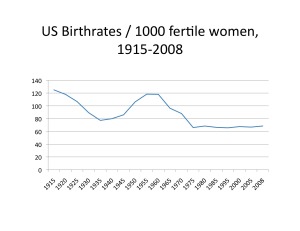Women’s Labor and Infertility
We ladies have a special relation to the word labor–it names the work we do for pay outside the house, the work we do for free at home, and that transitional, and frequently painful, hard physical work through which many of us directly produce the next generation for the nation.
The relation among all three realms of women’s labor has been in flux for decades. New farm technologies and our expanded life-spans mean the world just doesn’t need so many babies. Our understanding of women’s work has been especially mobile since the arrival of hormonal birth control in 1960, in concert with rising education and employment options.
Given the choice, women and their partners have opted to have fewer kids, delay their arrival, or decide against them altogether. Released from old biological constraints, women have flooded the universities and climbed career ladders, redefining “women’s work” by expanding it to include just about every field of endeavor, and doubling our national talent pool.
Absent supportive work policies, delay of kids has provided a shadow benefits system. Many women waited until their salaries and their on-the-job clout had grown and they could negotiate family-friendly schedules they wouldn’t have been able to get earlier on. As a result of their trickle up, women as a group have a new status in policy discussions, a status directly linked to their use of contraception to delay the arrival of kids–-some by a few years, others by many.
In 2007, 612,000 babies were born to women 35 and over (that’s 1 in every 7 babies), of which 105,071 were to women 40-44 and 7,349 were to women 45-54 [up from 1,375 20 years prior]).* But while some delay works for most, long delay brings difficulties.
Fertility wanes, and especially quickly between 40 and 43. But the desire to form a family often increases with age, especially now that women can hope to continue fit and healthy into their 80s; they’re better off financially; they’re more likely to be in a long-term relationship; they’ve accomplished many of their work ambitions and are ready to focus on family. Though they’re ready, their bodies don’t always cooperate.
In 15 states, women who encounter infertility for whatever reason** get some degree of insurance coverage for treatments – variously including IUI, IVF and egg donation, on a model similar to health-plan birth coverage. The infertility advocacy group Resolve states on its website that two thirds of infertile couples who seek medical intervention end up with a birth. In addition, many infertile couples and singles build happy families through adoption, while others end up without kids though they had hoped to have them – a situation full of ongoing sadness even when the people involved do move on to a revised life plan with happiness of its own.
In states that mandate full coverage, the average addition to everyone’s annual health bill was $3.14 in 1995, made low through economies of scale. In the other 35 states, you’re on your own and prices are high. Some can afford to pay $12,000 each for an IVF cycle or two, others can’t.
But society as a whole benefits when all citizens who want them can have kids when they’re ready–at the most basic level because we need a next generation of workers, but at another level because we want our citizens to be happy–for charitable reasons and more pragmatically because families are often what people work for, at whatever point they start them. In the end, it’s all about the labor force. Do we want educated couples excluded from the group of parents? Among those who encounter infertility, do we want only people who can afford the high cost of treatments to procreate?
In the past 50 years women have expanded their contributions in the workplace, and their education has grown the human capital of the nation. If sufficient numbers of women trickle up and change government support systems and business practice, future generations won’t have to delay in order to have both a family and a career to support them, though they may delay for other reasons.
There are lots of complexities to the modern fertility scene, and there’s plenty of room for misuse of new technologies as well as positive use. Which is which may not always be clear at first glance. As we move forward with health care reform, the expansion of infertility insurance to meet the needs of our expanding group of citizens who want to start their families later as well as people who encounter infertility from all causes should be part of the discussion, within a wider culture of care that assumes that all our citizens and families deserve basic supports, because we are our common wealth.
*The US birthrate to women 35-39 was 47.5 in 2007 and 26.2 in 1987; to women 40-44 it was 9.5/4.4; and to women 45-54 it was 0.6/0.2 (the rates are figured per 1000 fertile women).
**Female infertility isn’t just about delay–it can occur in younger women as well and is linked to increases in STDs, to PCOS (polycystic ovary syndrome–think Kate Gosselin), to endometriosis, to male factors, to environmental toxins, stress, and to other, unknown factors.




